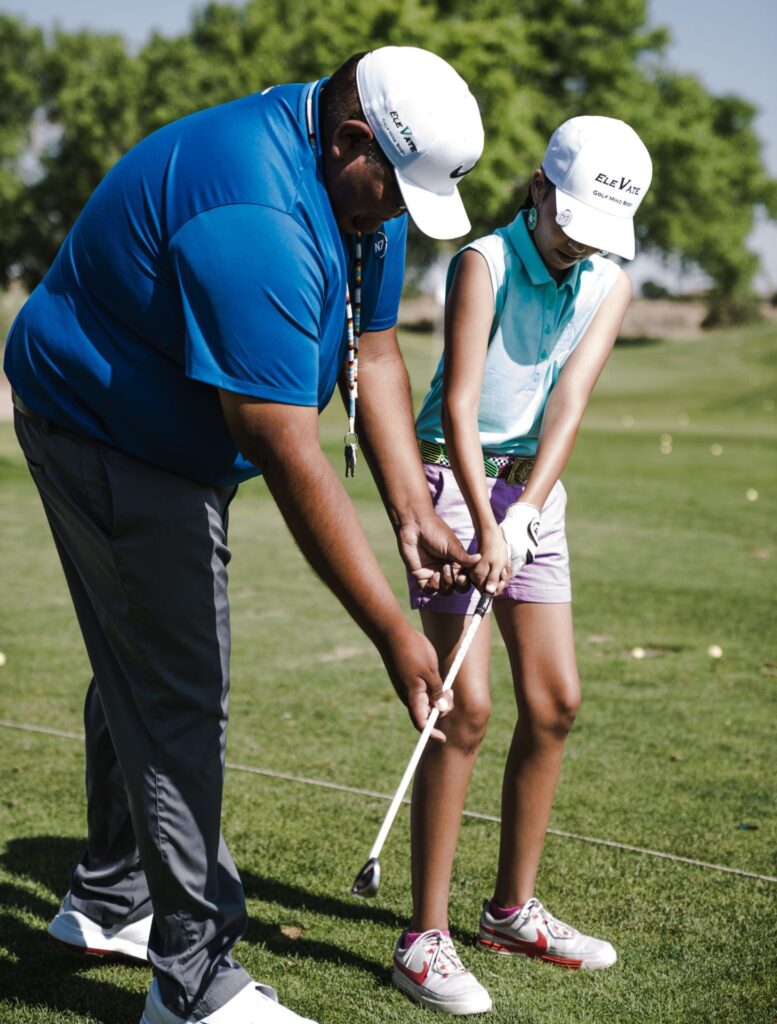Become a passionate player. Imagine playing golf with the best players in the world on the lush greens of major tournaments. There you are, you’re in the right place. Throughout this detailed guide, we will reveal the exciting secrets of how to turn your love of golf into a successful job as a professional golfer.

To become a professional golfer, you need to do more than just hit the ball into the hole. It’s an art that takes years of hard work, dedication, and unwavering love. There are a lot of exciting steps to take on this path to greatness, from perfecting your swing to learning the mental game.
If you’re ready to go on this trip, buckle up because we’re going to show you step-by-step how to get through the often difficult and unpredictable waters of professional golf. This blog post will go into great detail about the world of professional players. We will talk about the skills, training methods, and strategies that can help you become successful.
We’ll talk about how important it is to build a strong base with the right coaches and training programs, as well as how important it is to be physically and mentally strong to get through the challenges that lie ahead. During the course, we’ll give you useful tips, techniques, and examples from real life from professional players who are very good at what they do.
This guide will give you the information and tools you need to improve your golf game, no matter if you’re just starting out or already have a good score. You’ll have a clear plan by the end of this trip, which will allow you to follow your dreams and become a professional golfer. Put on your golf shoes and grab your clubs, and let’s start this amazing adventure together!
Understanding the Path to Professional Golf
It’s important to know what the next steps are before getting into the details of how to become a professional player. Getting to the top of the professional golfing world is not a sprint; it’s a race that takes time, patience, and unwavering commitment.
One of the first things you should do on this road is to figure out how skilled you are now and how much you can improve. Realistically figuring out where you stand in terms of your playing skills is very important. This self-evaluation will help you make goals that you can reach and a plan for how to get better.
Next, it’s time to get the right help and coaching. In any activity, building a strong base is very important, and golf is no different. It can make a huge difference to work with experienced teachers who can look at your swing, fix any problems they find, and make training plans just for you.
Not only do coaches help you improve your technical skills, they also give you great advice on how to handle the course, come up with strategies, and keep your mind strong, all of which are very important in professional golf. They will teach you discipline and strength as they lead you through the ups and downs of this difficult trip.
Building a Strong Foundation: The Importance of Proper Coaching
To become a professional golfer, you need to start by doing well in school and getting good teaching. A good teacher can tell you what parts of your game you need to work on and create training plans that will help you do that.

Getting a teacher will help you get better at golf in general, make your swing more consistent, make better shots, and fix any issues with the way you hit the ball. They will also work on your short game skills, like how to putt, chip, and play in bunkers. These skills are important for winning or losing a round of golf by a lot of strokes.
A teacher does a lot more than just show you how to play the game. They change the way you think about it too. To help you get in the right frame of mind, they will teach you how to stay focused, deal with stress, and move on from problems. Smart people often make the best players stand out.
Along with regular lessons and training on the course, a good teacher also sets these up. Your teacher will set up practice games that are like real ones, so you can get better while being pushed. They will be with you during practice rounds and help you figure out how to play the game and pick your shots.
Mastering the Fundamentals: Perfecting Your Swing
The foundation of any golfer’s game lies in their swing – a fluid motion that combines power, accuracy, and consistency. Mastering the fundamentals of the golf swing is crucial for aspiring professional golfers.

A good golf swing is a series of coordinated movements that make the clubhead move as fast as possible while keeping control of the ball’s path. It needs exact timing, body positioning, grip technique, and weight transfer.
To get better at your swing, you need to work on each part separately before putting them all together in a smooth move. As part of this process, you may need to break down your swing into smaller parts and focus on drills or routines that work on those parts.
To make the right swing movements part of your muscle memory, you need to practice often. Repeating helps you become more consistent and gives you the confidence to make shots in a variety of situations. Using film analysis tools can also help you understand how your swing works and find places where you can improve.
Mental Fortitude: Developing a Winning Mindset
Golf is as much a mental game as it is physical. Developing a winning mindset is crucial for success as a professional golfer. The ability to stay focused, remain calm under pressure, and bounce back from setbacks can make all the difference during competitive rounds.
Setting clear goals and picturing yourself succeeding is one of the first things you can do to build mental toughness. Visualizing yourself reaching your goals gives you a good attitude that keeps you motivated and determined.
Keeping your feelings in check is another important part of mental toughness. It’s important to stay calm even when things don’t go as planned in golf, which can be stressful. You can get better at letting go of mistakes, being patient, and being in the present moment by practicing and becoming more self-aware.
Visualization techniques, breathing exercises, and pre-shot routines are other tools that professional golfers use to stay mentally sharp on the course. These strategies help calm nerves, maintain focus, and execute shots with confidence.
Training Regimens and Techniques for Professional Golfers
Becoming a professional golfer requires a disciplined training regimen that focuses on both physical fitness and technical skill development. Professional golfers spend hours honing their craft through targeted practice sessions, physical conditioning, and strategic planning.
A typical training regimen for professional golfers includes daily practice sessions that cover all aspects of the game – from full swing drills to short game work. These sessions are designed to improve technique, build consistency, and enhance shot-making abilities.
Professional golfers work on their fitness levels by doing strength training workouts in addition to practicing on the course. Getting stronger in your core, being flexible, and being stable all help you hit harder and avoid getting hurt.
Professional golfers also focus on improving their physical endurance through cardiovascular exercises such as running or cycling. Endurance plays a crucial role in maintaining focus throughout long tournament rounds.
The Role of Physical Fitness in Professional Golf
Professional golfers need to be in great shape to do well. Not only does it improve ability, but it also lowers the risk of injury and helps athletes stay in the sport longer.
A well-rounded fitness program for professional golfers includes strength training, flexibility exercises, cardiovascular workouts, and mobility drills. These components work together to improve overall athleticism and enhance golf-specific movements.
The main goals of strength training are to make the core stronger, the upper body more stable, and the lower body stronger. This helps speed up the clubhead, keep control of the swing, and lower the risk of getting hurt.
To keep your golf swing’s full range of motion, you need to do flexibility workouts. Stretching routines that focus on hips, shoulders, and back, which are important muscle groups for the swing, can help you become more flexible and avoid muscle imbalances.
Cardiovascular exercises help build endurance, which helps golfers stay focused and do their best during long competition rounds. As part of their fitness practice, golfers can do things like jogging, swimming, or cycling.
Navigating the Competitive Landscape: Tournaments, Qualifications, and Rankings

Professional golf is a very competitive sport, and every year there are events all over the world. To find your way around this area, you need to know how tournaments work, how to qualify, and how scores work.
There are different groups where professional golfers play, such as the PGA Tour for men and the LPGA Tour for women. Throughout the year, these tours hold events where players can win money based on how well they do.
Aspiring professional golfers often have to go through a series of qualifying rounds called “Q-Schools” in order to get on these tours or certain events within them. A golfer’s skills are put to the test against other potential pros at these events, which also lead to bigger competitions.
Rankings systems play a crucial role in determining eligibility for certain tournaments. The Official World Golf Rankings (OWGR) and Rolex Rankings (for women’s golf) are widely recognized systems that rank professional golfers based on their performance in sanctioned events.
A popular way for people who want to be professional golfers to get started is to do well in lower-level tournaments and work their way up the rankings.
Balancing Professional Golf with Personal Life: Challenges and Strategies
Becoming a professional golfer can be very beneficial, but it can also be hard at times. To balance the responsibilities of professional golf with personal life, you need to plan ahead, find support systems, and learn how to use your time well.
It can be hard for professional golfers to keep up with their personal ties because they spend so much time traveling to tournaments. It’s important to stay in touch with family and friends and build a support system of people who understand the needs of the job.
Managing your time well is another important part of balancing work and home obligations. Making routines, setting realistic goals, and setting priorities can help you meet your personal and business obligations.
For long-term success in competitive golf, it’s also important to take care of your physical and mental health. Taking time to rest, recover, and do things that are good for you can help you avoid burnout and keep your life in order.
Learning from the Pros: Insights and Advice from Accomplished Golfers
The advice and tips you can get from people who have already been successful in professional golf are very helpful on your own path. Professional golfers give tips on all parts of the game, from how to play better to how to think about your shots.
Professionals often say that instead of comparing yourself to others, you should focus on getting better all the time. Every golfer’s journey is different, and so are their skills and weaknesses. It’s important to follow your own road and work toward your own goals.
Professionals also stress how important it is to be patient and determined. In professional golf, the path to success is rarely a straight line, and failures are bound to happen. It’s important to keep a good attitude, learn from your mistakes, and keep going.
One more important thing that experts teach is how important it is to enjoy the process. It takes a lot of time and effort to get good at golf, but it’s important to enjoy the process. Accepting the difficulties, enjoying the small wins, and admiring the beauty of the sport can keep you motivated and passionate.
Conclusion: Taking the Next Steps towards a Professional Golf Career
Excellent work! Now you’ve read everything you need to know to become a professional player. At this point, you should have a good idea of what you need to do to become a professional golfer.
Keep in mind that this journey needs steadfast commitment, constant improvement, and mental toughness. Setting yourself up for success by getting the right coaching, learning basic skills like how to swing, developing a winning attitude, and making fitness a part of your training routine are all very important.
The competitive world of professional golf can be hard to get used to at first, but if you stick with it and plan ahead, you can move up through tournaments and ranks.
Finally, don’t forget to enjoy every step of this amazing journey. In golf, it’s not just about getting to the end goal; it’s also about enjoying the journey and each swing. Put your golf shoes on and grab your clubs—it’s time to hit the first tee!
